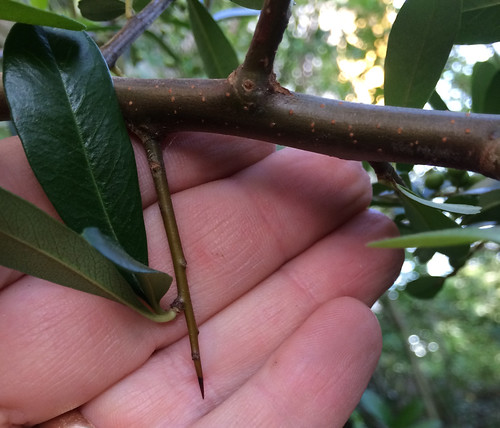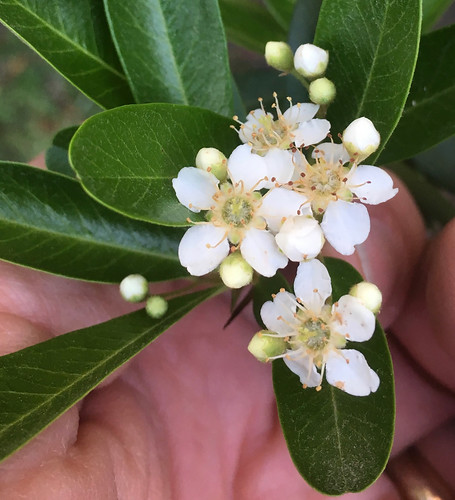Abundance: plentiful
What: berries
How: raw, syrup, jelly, dehydrated fruit leather
Where: landscaping, woods
When: fall
Nutritional Value: vitamin C when raw or dehydrated
Dangers: thorns contain a natural, painful irritant

Leaves and thorns

Thorn

Close-up of flower

Unripe fruit, April in Houston. Note the "crowns" at the base of the fruit.

Almost ripe, October in Houston.

Fully ripe and ready to be made into jelly, January in Houston.

Texas distribution, attributed to U. S. Department of Agriculture. The marked counties are guidelines only. Plants may appear in other counties, especially if used in landscaping.

North American distribution, attributed to U. S. Department of Agriculture.

Fall brings forth a lot of different red berries in Texas, both wild and landscaping. One of the most thickly-covered red berry bushes is Pyracantha. These started out as a non-native landscaping plant but due to birds LOVING these berries, the seeds have been spread far and wide. Finding these thorn-covered bushes in the wild is becoming more and more common. The alternative name for these is "fire thorn" because the tips of its long, sharp thorns contain a powerful irritant, making any scratch from it hurt a lot more than expected.
Ripe, red Pyracantha (aka fire thorn) berries are a bland food but high in vitamin C. The most common use for these berries is to make jelly. Like with beautyberry, you need to add a lot more pectin to the syrup to get it jell up properly, up to doubling the amount pectin for a proper jelly. Some cinnamon improves the apple-like flavor. The end result will have lost a lot of its vitamin C due to the cooking process.
The best place to plant these evergreen shrubs is in front of large, first-floor windows. Their sharp, irritating thorns make an excellent barrier, sending thieves looking for an easier target. Food and protection in one plant! Prune it 1-2 times a year to shape the wall of thorns. If you're a birdwatcher, placement by a window will give you a front row seat as cedar waxwings and other birds show up to devour these berries.
Buy my book! Outdoor Adventure Guides Foraging covers 70 of North America's tastiest and easy to find wild edibles shown with the same big pictures as here on the Foraging Texas website.

